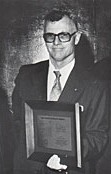- unknown (b.)
Bio/Description
A Solid-State Engineer at RCA Laboratories in Princeton, New Jersey in the 1950's and early 1960?s, he was born and raised in Orange, New Jersey. His father had emigrated from England to the U.S. as a teenager, and his mother?s family had emigrated from Germany. He attended public school in South Orange and went to the Lawrenceville School, a secondary school in New Jersey for the last three years of his secondary education. He earned his Electrical Engineering degree from Yale in the summer of 1950, having studied Servo Mechanisms and Mathematics under Pete Schultheiss and John Bowers. Soon after graduation he went to work at RCA. In college he had worked with sophisticated feedback circuits and that work was directly applicable to his work at RCA, utilizing concepts he had learned in servo mechanisms. He began in the research-training program which allowed him to work in different areas at the labs. His first exposure to semiconductors was with a man named Loy Barton and they built a transistor radio. His first permanent assignment was with the Industry Service Laboratory [ISL] under Al Barco. Their responsibility being to make sure that the RCA licensees, from whom RCA derived a significant income, were abreast of what RCA was doing. In 1959 William Webster, Vice President at RCA appointed him as a dual group head in both the Systems Research Laboratory and the Electronics Research Laboratory. Extrapolating from some signal-to-noise ratio discussions that William Webster and Harry Olson had earlier engaged in, his group, in 1960, calculated the potential for storing and retrieving information from a vinyl disc using a form of information storage known as electrical capacitance. This was the CED concept ultimately adapted for the RCA VideoDisc system. He concluded that video could be stored on such a disc if signal elements of sufficiently small size could be engraved in its surface. But the technology to accomplish this did not exist in 1960. Other priorities at RCA Labs delayed further investigation of the CED concept until 1964. At the RCA Laboratories spring Directors' meeting that year, four information research projects were modestly funded, one based on magnetic tape and the other three (which came to be known as Discpix, Photopix, and Holopix) based on non-magnetic media. The Discpix team headed by Eugene Keizer took up where he left off in 1960, and the team was greatly complemented when Jon Clemens joined the project in 1965. He joined the new Business Evaluation staff in 1966 when William Webster became Vice President of Materials and Device Research. In 1968, he became Director of the newly formed Consumer Electronics Laboratory after Webster became President of RCA Laboratories. Having these two proponents of the capacitive encoding concept in powerful management positions allowed the Discpix project to survive the difficult basic research stages of the late 1960's. For his fundamental investigation of the CED concept, he was awarded US Patent No. 3783196 on January 1, 1974. This was one of the first three CED patents filed on March 22, 1971, ten years to the day before the market introduction of the RCA VideoDisc system. He was presented with a special plaque by RCA Chairman Thornton F. Bradshaw at the David Sarnoff Awards presentation honoring his early contributions to RCA's VideoDisc developments. The plaque depicts one of his early patents which led to today's VideoDisc. He was cited as "a visionary who, not only foresaw the CED videodisc system long before its time, but provided the technical encouragement and management support necessary to bring that vision to a reality." William M. Webster, Vice President RCA Laboratories, and William C. Hittinger, Executive Vice President, Research and Engineering, attended the presentation.
-
Noted For:
Fundamental investigator of the CED concept, which led to the development of the RCA VideoDisc system -
Category of Achievement:
-
More Info:


